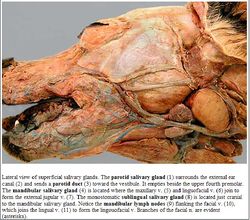Difference between revisions of "Zygomatic Gland - Anatomy & Physiology"
Jump to navigation
Jump to search
| Line 1: | Line 1: | ||
==Overview== | ==Overview== | ||
| − | The zygomatic gland is found only in carnivores. The duct opens in a vestibule on the mucosal ridge by four or five orifices. It is innervated by the '''glossopharyngeal nerve''' ([[Cranial Nerves - Anatomy & Physiology|CN IX]]) via the trigeminal branch | + | The zygomatic gland is found only in carnivores. The duct opens in a vestibule on the mucosal ridge by four or five orifices. It is innervated by the '''glossopharyngeal nerve''' ([[Cranial Nerves - Anatomy & Physiology|CN IX]]) via the trigeminal branch. |
[[Image:Salivary Glands Dog.jpg|thumb|right|250px|Salivary Glands Labelled (Dog) - Copyright C.Clarkson and T.F.Fletcher University of Minnesota]] | [[Image:Salivary Glands Dog.jpg|thumb|right|250px|Salivary Glands Labelled (Dog) - Copyright C.Clarkson and T.F.Fletcher University of Minnesota]] | ||
Revision as of 22:59, 30 December 2010
Overview
The zygomatic gland is found only in carnivores. The duct opens in a vestibule on the mucosal ridge by four or five orifices. It is innervated by the glossopharyngeal nerve (CN IX) via the trigeminal branch.
Histology
The zygomatic gland is a tubulo-acinar gland, made up of mainly mucosal cells (lighter stain). There are a few serous demilunes but they form only a minor contribution (darker stain).
Links
Click here for the salivary gland flashcards.
